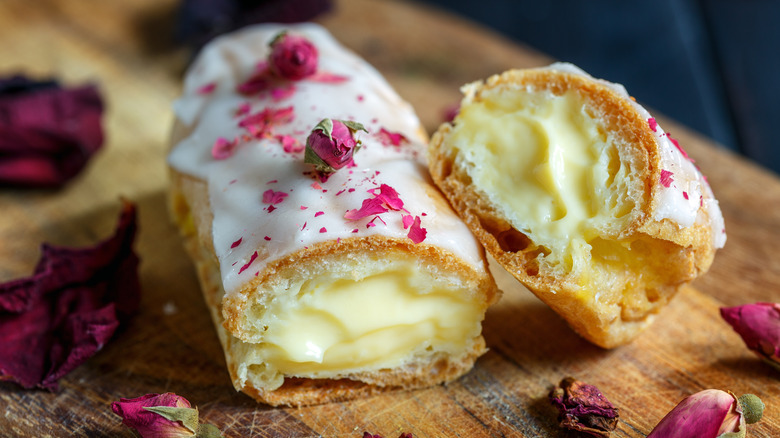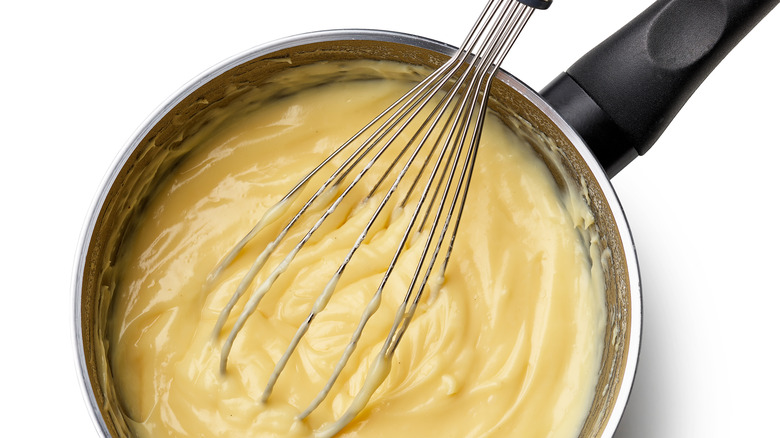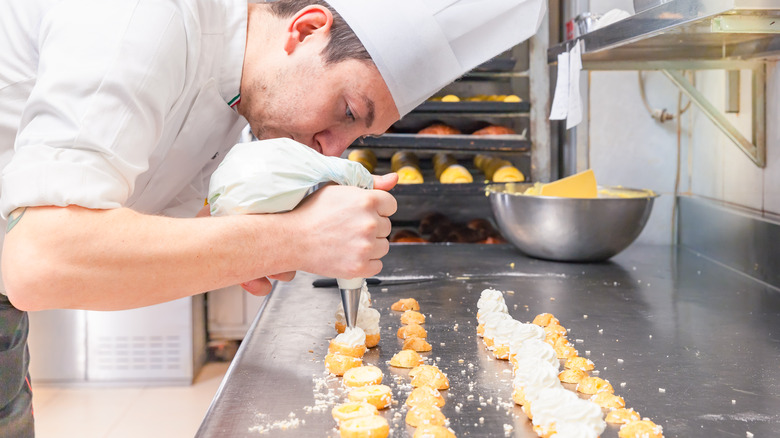The Whisking Tip For Evenly Cooked Pastry Cream
What do éclairs, cream puffs, and Boston cream pie all have in common? They're all filled with sweet, thickened pastry cream, which is made with a mixture of egg yolks, sugar, and flour or cornstarch. Pastry cream is one of the most versatile items in any baker's arsenal because it can fill the layers of a cake, make the base of a fruit tart, and even get piped into hot, fresh donuts. Lots of amateur bakers shy away from making pastry cream, however, because it's easy to get lumpy, gloppy results if you're not careful. Unevenly cooked pastry cream might still taste good, but it won't pass through the tip of a pastry bag very well, and it looks kind of unprofessional. But there's no big secret to making perfectly silky and smooth pastry cream — all you have to do is whisk it constantly until it's cooked.
Pastry cream is a custard, which means that it's a liquid that's thickened with egg. Pastry cream is a bit of its own animal because it's also thickened with flour, so it's not as easy to curdle it like ice cream base or creme brûlée, but it's easy to scorch the bottom of the pot if you're not paying attention. Make sure when you've got a batch of pastry cream on the stove that you don't walk away — and don't stop stirring.
It's all about even cooking
Pastry cream is fairly bulletproof when compared to other custards. In fact, you can bring pastry cream almost to a boil without worrying about breaking (or curdling) it. That doesn't mean that you can set it and forget it on the stove, however. As the liquid in the pot warms up, two things happen: The egg yolks cook and thicken, and the starch molecules from the flour or cornstarch gelatinize.
When the thickening starts to happen, usually around 124–140 degrees Fahrenheit, it's especially important to continuously whisk your pastry cream. This is because when the mixture starts to get thick, it's easy for it to collect at the bottom of the pot — where the heat is — and overcook. But if you're diligently whisking the whole time, all of the pastry cream has a chance to circulate.
A wire whisk is the tool of choice for stirring a batch of pastry cream because it will cut through the liquid as it gets progressively thicker — plus, it will scrape up any pastry cream that's collecting on the bottom of the pot. A wooden spoon, on the other hand, won't mix the pastry cream evenly, and you'll get pockets that remain uncooked.
If you want extra-smooth pastry cream, strain it
Most of the time when you make pastry cream at home, it seems like it's still not quite as refined as the stuff you'd get at a bakery. This is because most professional bakers take the extra step of straining their pastry cream through a fine mesh sieve while it's still hot. While it's not a required step, a fine mesh sieve will catch any eggy clumps that may have formed in the pot and break up any uneven textures. All you have to do is set up a bowl with the sieve on top. When the pastry cream is finished on the stove, pour it right into the sieve while it's hot. If the pastry cream is a little too thick to get through the mesh, use a ladle to gently push it through using an up-and-down motion.
Once you have your super smooth pastry cream ready to go, the last step to keep it from getting lumpy is to cover it with a layer of plastic wrap laid right on top of the surface of the pastry cream. Just like pudding, if it's allowed to cool while touching any air, it will form a thick skin on top that you'll have to scrape away later — and nobody wants to waste any precious pastry cream.


